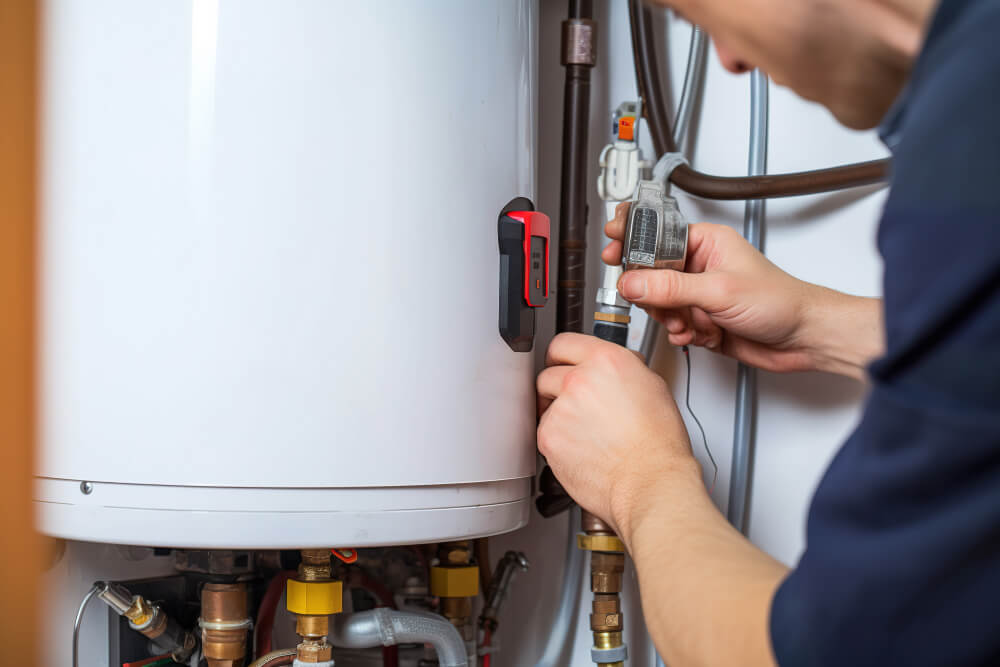1. Leaky Faucets
Problem: A dripping faucet is not only annoying but can also waste a significant amount of water over time. Cause: Leaky faucets are usually caused by worn-out washers, O-rings, or seals. Fix:- Turn off the water supply: Locate the shutoff valves under the sink and turn them off.
- Disassemble the faucet: Remove the handle and use a wrench to unscrew the packing nut.
- Replace the washer or O-ring: Identify the worn part and replace it with a new one of the same size.
- Reassemble the faucet: Put the faucet back together and turn on the water supply to check for leaks.
2. Clogged Drains
Problem: Slow or clogged drains are common in kitchens and bathrooms. Cause: Clogs are usually caused by a buildup of hair, soap, grease, or food particles. Fix:- Plunger: Use a plunger to dislodge the clog. Ensure there’s enough water to cover the plunger’s cup and create a seal.
- Drain Snake: For stubborn clogs, use a drain snake to reach and break up the blockage.
- Baking Soda and Vinegar: Pour a mixture of baking soda and vinegar down the drain, let it sit for 30 minutes, then flush with hot water.
- Preventive Maintenance: Use drain strainers to catch debris and avoid pouring grease down the drain.
Join HICP Homeowner’s Alliance
Connect with experts, get special discounts and enjoy member benefits
3. Running Toilets
Problem: A running toilet can waste a lot of water and increase your water bill.
Cause: Common causes include a faulty flapper valve, a malfunctioning fill valve, or a misaligned float.
Fix:
- Inspect the Flapper Valve: Check if the flapper is sealing properly. If not, replace it.
- Check the Fill Valve: Ensure the fill valve shuts off when the tank is full. Adjust or replace if necessary.
- Adjust the Float: If the float is too high or too low, adjust it to the correct level to stop the water from running.
4. Low Water Pressure
Problem: Low water pressure can make everyday tasks like showering and washing dishes frustrating.
Cause: Causes include mineral buildup in pipes, a faulty pressure regulator, or leaks.
Fix:
- Clean Aerators: Remove and clean the aerators on faucets to remove any mineral buildup.
- Check for Leaks: Inspect visible pipes for leaks and repair any you find.
- Pressure Regulator: If you suspect the pressure regulator is faulty, have it inspected and replaced by a professional.
5. Water Heater Issues
Problem: Inconsistent hot water or no hot water at all can be a major inconvenience.
Cause: Common causes include a faulty thermostat, sediment buildup, or a malfunctioning heating element.
Fix:
- Check the Thermostat: Ensure the thermostat is set to the correct temperature (usually around 120°F or 49°C).
- Drain the Tank: Drain a few gallons of water from the tank to remove sediment buildup.
- Inspect the Heating Element: If you have an electric water heater, check the heating element for continuity and replace it if necessary.
6. Leaky Pipes
Problem: Leaky pipes can cause water damage and mold growth in your home.
Cause: Pipes can leak due to corrosion, high water pressure, or joint issues.
Fix:
- Temporary Fix: Use pipe clamps or epoxy putty for a temporary fix until you can replace the damaged section.
- Permanent Fix: Replace the leaky section of the pipe. Cut out the damaged section and replace it with a new piece, using appropriate fittings and soldering or pipe connectors.
- Preventive Measures: Regularly inspect pipes for signs of wear and tear and maintain a consistent water pressure within the recommended range.
7. Sump Pump Failure
Problem: A failed sump pump can lead to basement flooding during heavy rain.
Cause: Causes include power failure, a clogged discharge pipe, or a stuck float switch.
Fix:
- Check the Power Supply: Ensure the sump pump is plugged in and receiving power. Consider a battery backup system for power outages.
- Clean the Discharge Pipe: Remove any debris from the discharge pipe to ensure proper drainage.
- Inspect the Float Switch: Make sure the float switch is not stuck or obstructed. Clean or replace it if necessary.
8. Sewer Line Backup
Problem: Sewer line backups can cause raw sewage to back up into your home, creating a health hazard.
Cause: Backups are often caused by tree roots, grease buildup, or collapsed pipes.
Fix:
- Call a Professional: Sewer line issues typically require professional intervention. Plumbers can use cameras to inspect the line and determine the cause.
- Preventive Maintenance: Regularly clean your sewer line and avoid flushing non-degradable items down the toilet.
9. Noisy Pipes
Problem: Noisy pipes, often referred to as “water hammer,” can be startling and indicate underlying issues.
Cause: Causes include loose pipes, high water pressure, or water hammer.
Fix:
- Secure Loose Pipes: Use pipe clamps or straps to secure loose pipes and reduce noise.
- Install Water Hammer Arrestors: These devices absorb the shock caused by water suddenly stopping or changing direction.
- Adjust Water Pressure: Ensure your home’s water pressure is within the recommended range (40-60 PSI).
Understanding and addressing common plumbing problems can help you maintain a functional and efficient plumbing system in your home. While many issues can be fixed with simple tools and techniques, don’t hesitate to call a professional plumber for more complex problems or if you’re unsure about the proper solution. Regular maintenance and prompt repairs will keep your plumbing system running smoothly and prevent minor issues from escalating into costly repairs.








